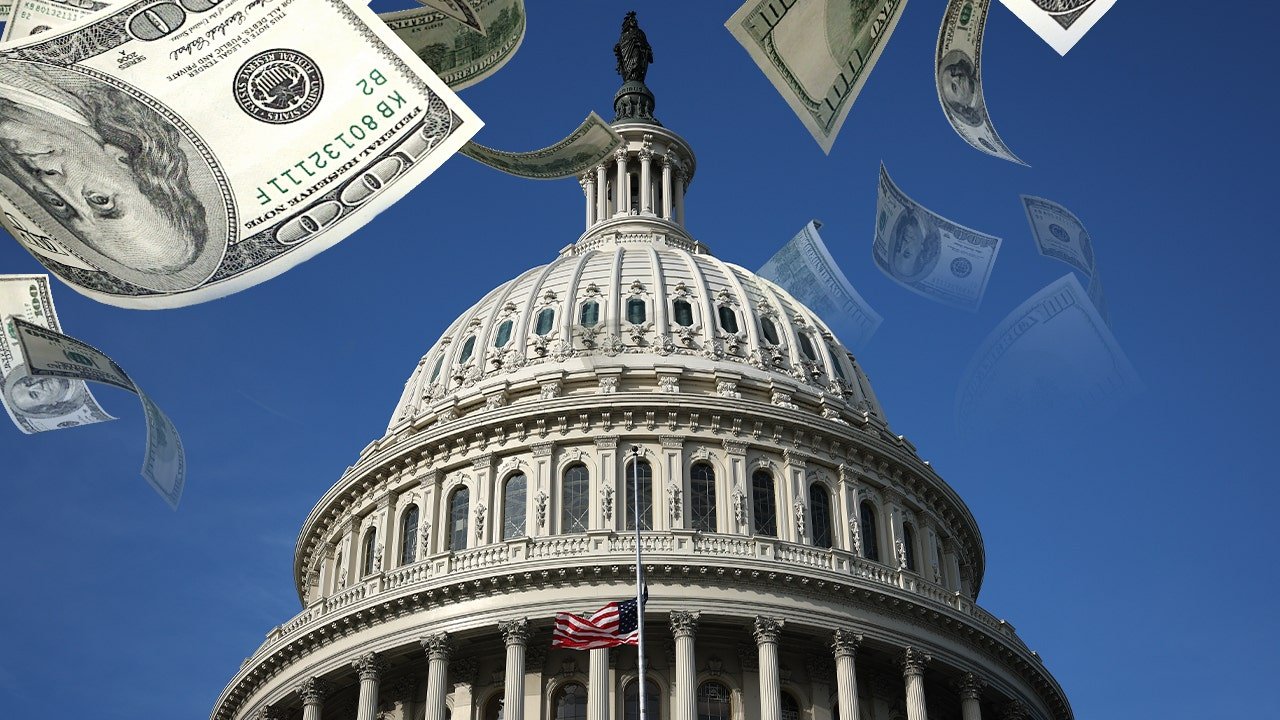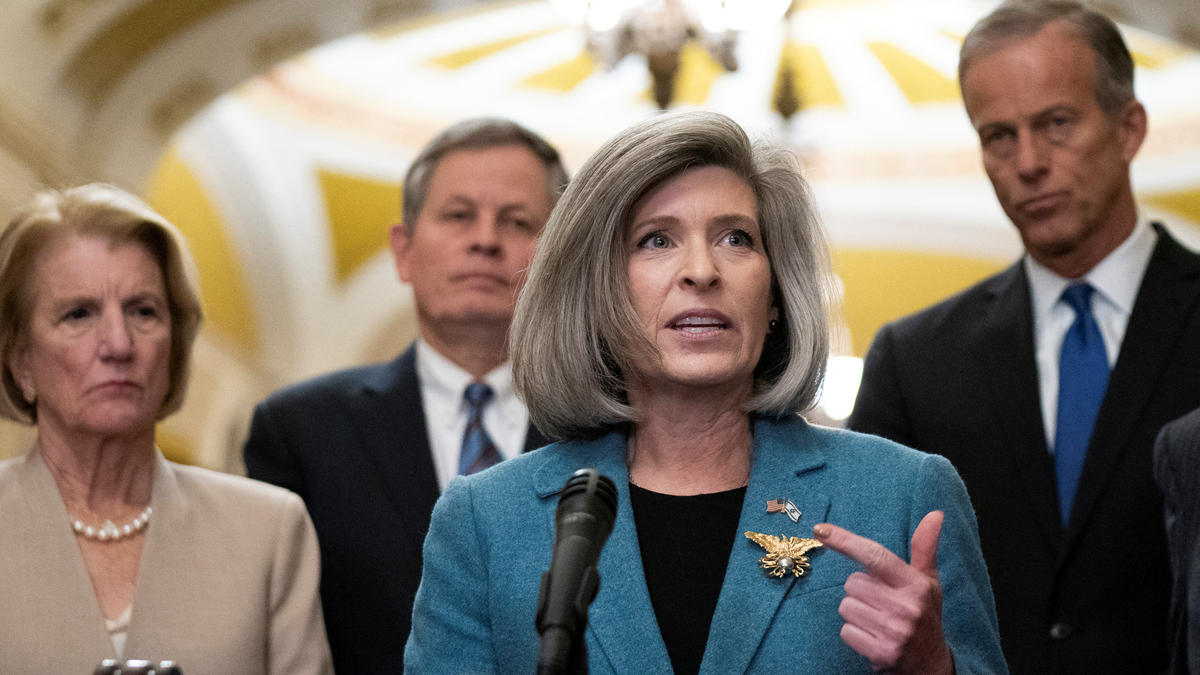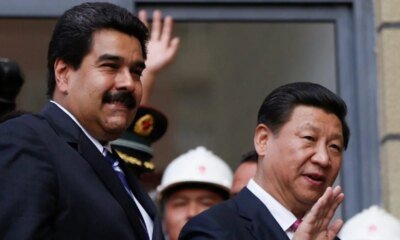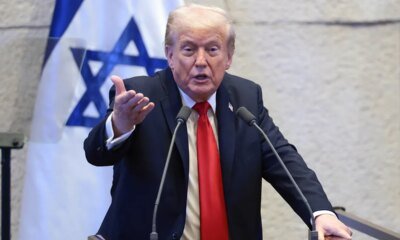INTERNACIONAL
Major Chinese bridge collapses into river just months after opening to traffic

NEWYou can now listen to Fox News articles!
A massive bridge at a hydropower station in southwest China collapsed Tuesday, sending concrete and steel plunging into a river just months after it opened, according to Chinese state media.
Reuters reported that an official from Barkam County confirmed the collapse to the Chinese state-run Global Times, saying no casualties had been reported.
The report added that cracks were detected a day earlier on the bridge’s road surface and slope, prompting authorities to impose temporary traffic controls.
Footage of the collapse, shared widely on Chinese social media, showed the Hongqi Bridge in Sichuan Province buckling before falling into the river below, kicking up a massive cloud of dust.
COLUMBIA UNIVERSITY STUDENT AMONG 5 KILLED IN NEW YORK TOUR BUS CRASH AFTER NIAGARA FALLS VISIT
Dust and debris rose over the gorge after the Hongqi Bridge gave way in Sichuan Province on Nov. 11, 2025, following reports of cracks a day earlier. (Reuters)
The incident occurred around 3 p.m. local time near the G317 national highway, according to China Central Television (CCTV) News.
Local transportation and public security bureaus said the right-bank slope of the bridge showed signs of deformation Monday afternoon, just hours before the collapse.
Authorities quickly shut down the structure to all traffic and issued a public notice warning of potential safety risks.
CLIMBER DIES NEAR MOUNT EVEREST, WHERE HIKERS BEGIN TO EVACUATE AFTER SNOWSTORM

The Hongqi Bridge near a hydropower station in southwest China collapsed into the river below on Nov. 11, 2025, in a dramatic failure that was caught on camera. (Reuters)
According to Times Now, the Hongqi Bridge was located in Sichuan Province’s mountainous Maerkang area and completed earlier this year as part of the G317 national highway—an important route connecting central China to Tibet.
The 758-meter-long, cantilevered two-lane beam bridge stood roughly 625 meters above the gorge floor, with piers reaching up to 172 meters in height. It was built by the state-backed Sichuan Road & Bridge Group as part of efforts to expand access to the Tibetan Plateau.
3 WORKERS REMAIN HOSPITALIZED AFTER COLLAPSE OF CLOSED BRIDGE IN RURAL MISSISSIPPI KILLED CO-WORKERS

Sections of the Hongqi Bridge fell into the river during a catastrophic collapse in Sichuan’s Maerkang area on Nov. 11, 2025, prompting an immediate investigation. (Reuters)
The bridge’s construction was part of a broader government push to improve connectivity and spur economic growth across western China’s rugged terrain, Times Now reported.
It was intended to serve as a symbol of the country’s infrastructure ambitions but had only reopened to traffic a few months before the collapse—marking a short-lived chapter for what was meant to showcase China’s engineering progress.
CLICK HERE TO DOWNLOAD THE FOX NEWS APP
State-run outlets have not yet identified the cause of the collapse, though early assessments suggest geological instability may have played a role. No vehicles or pedestrians were on the bridge at the time, officials said, and investigations are underway.
Reuters contributed to this report.
china,disasters,travel
INTERNACIONAL
Chatbots de derecha impulsan guerras políticas y culturales en Estados Unidos

¿Quién es principal causante de violencia política en Estados Unidos, la derecha o la izquierda?
Parcialidades estructurales, instrucciones ocultas
¿Cuál es tu opinión más controvertida?
Chatbots con sesgos y el proyecto de la red social de Trump
INTERNACIONAL
Big Paychecks, Bigger Problems: How a bloated bureaucracy exposes Congress’ funding failure

NEWYou can now listen to Fox News articles!
FIRST ON FOX: A new report from a government watchdog group begs the question of why — with nearly 800,000 federal bureaucrats drawing six-figure salaries and the average payroll of the federal workforce far outpacing its size — is Washington still unable to fund the basics of government?
Open The Books, a project of American Transparency, a 501(c)3 nonprofit, nonpartisan charitable organization, closely tracks government spending and released an expansive report Wednesday ahead of a looming agreement between Republicans and Democrats to reopen the government, showing the swamp has gotten bigger, richer and more secretive since 2020.
The report, which analyzed all publicly disclosed federal salaries for fiscal year 2024, found a total of 2.9 million civil service employees with a total payroll of $270 billion, plus an additional 30% for benefits. While the total number of employees rose by 5% since 2020, payroll grew nearly five times as much.
DEPT OF ED SPENDING SOARED 749% DESPITE DOWNSIZING, NEW DOGE-INSPIRED INITIATIVE REVEALS
A graphic from Open The Books’ new report highlights how overlays have expanded at nearly five times the rate of federal bureaucracy. (Open The Books)
The current federal workforce is costing American taxpayers $673,000 per minute, $40.4 million per hour and just under $1 billion per day, according to Open The Books. This includes almost 1,000 workers who are making more than the president’s $400,000 per year salary, 31,452 non-War Department federal employees who made more than every governor of all 50 states and 793,537 people making $100,000 or more. Those making $300,000 or more have seen an 84% increase since 2020, while there has similarly been an 82% increase in those earning $200,000 or more, the report points out.
During Open The Book’s investigation, the fiscal watchdog group also found that the names of 383,000 federal workers across 56 different agencies were redacted, amounting to a total of $38.3 billion in pay. According to Open The Books CEO John Hart, «You can’t have accountability without visibility.»
«The Trump administration has a historic opportunity to bring much-needed transparency to the administrative state. While federal employees don’t add as much to the debt as safety net programs, defense and overall agency spending, they are an indicator of government’s growth,» Hart said in a statement to Fox News Digital.
«Our investigators found far too many redactions and blind spots that DOGE should have already fixed. You can’t have accountability without visibility. Taxpayers need a much clearer picture of the federal workforce than they have today.»
U.S. Sen. Joni Ernst, R-Iowa, has been working with Open The Books to fight for greater transparency. In a letter sent in September to Scott Kupor, the director of the U.S. Office of Personnel Management (OPM), Ernst said she had identified «numerous examples» of full-time federal employees earning two salaries while moonlighting for other agencies or government contractors, something typically prohibited under the law. Ernst pointed out that this was being done without the approval or knowledge of these workers’ managers.
FAR-LEFT FIREBRAND SPENDS EYE-POPPING AMOUNT OF CAMPAIGN CASH ON LUXURY HOTELS, ‘TOP-TIER’ LIMO SERVICES

Sen. Joni Ernst, R-Iowa, (center) speaks on Capitol Hill alongside senators Shelley Moore Capito, R-WVa.; Steve Daines, R-Mont; and John Thune, R-S.D. (Reuters)
«From 2021 to 2024, a Department of Housing and Urban Development (HUD) employee held multiple other full-time government contractor jobs, frequently billing taxpayers for more than 24 hours of work in a single day,» Ernst chronicled in her letter. «In addition to HUD, she was paid by AmeriCorps and the National Institutes of Health. Since she teleworked in all three positions, she was able to hide her overlapping jobs and get away with billing taxpayers $225,866 for hours she never worked. She claimed she worked 26 hours on 13 of the 21 workdays in a single month.»
Ernst also described a second example of a human resources official at the Peace Corps who was caught falsifying time cards submitted to different agencies, which led to the employee double-billing taxpayers for tens of thousands of dollars. She laid out several other examples in the letter as well.
«Until recently, outside of death and taxes, the expanding Washington bureaucracy was one of the few certainties in life,» said Ernst. «I am proud to have partnered with the Trump administration and DOGE to successfully downsize the bloated bureaucracy, but there is much more work to be done to make Washington more efficient.»
One can «look no further» than the «failed Schumer shutdown,» Ernst said, pointing out that taxpayers will be on the hook for more than $12 billion in back pay for 750,000 non-essential federal employees who did not work for a month and a half.

The U.S. capitol building in Washington, D.C. (Win McNamee/Getty Images)
CLICK HERE TO GET THE FOX NEWS APP
In October, Ernst introduced the Non-Essential Workers Transparency Act, aimed at providing the public with an exact accounting of how much back pay the government will be required to fork over in the case of a shutdown.
The bill would require executive agencies to submit detailed reports to Congress within 30 days of a lapse in appropriations that must include the total number of employees and contractors employed by the agency at the time of the shutdown, the total salaries paid by the agency during the prior fiscal year, the number of furloughed during the lapse and their annual pay, the number of employees not furloughed and the sum of their pay and a requirement that all this information be posted publicly on the agencies’ websites.
budgets,spending,finance economy,economy,politics,budget house of representatives politics,budget senate
INTERNACIONAL
Estados Unidos impuso sanciones contra una red global vinculada al programa de misiles y drones de Irán

El gobierno de Estados Unidos anunció este miércoles la imposición de sanciones financieras contra una red de empresas e individuos en distintos países por su presunta colaboración con el programa de fabricación de misiles balísticos y drones de Irán.
El Departamento del Tesoro estadounidense incluyó en su lista a 32 entidades y personas ubicadas en Irán, China, Hong Kong, Emiratos Árabes Unidos (EAU), Turquía y la India. Esta decisión, explicada por la Administración de Donald Trump como un respaldo a la reciente reimposición de sanciones internacionales, busca aislar aún más a la República Islámica y frenar su desarrollo nuclear y militar.
El anuncio se produce después de que el Consejo de Seguridad de la ONU restableciera en septiembre seis resoluciones de sanciones adoptadas entre 2006 y 2010. Según argumentaron los miembros del Consejo, Irán no ha cumplido con los compromisos de control de su programa nuclear asumidos en el acuerdo firmado en 2015. Esta postura internacional es consecuencia directa de una escalada de tensiones: Washington abandonó el acuerdo nuclear con Irán en 2018, durante el primer mandato de Trump, y volvió a imponer sanciones. Ante esto, Teherán aceleró su desarrollo atómico y, tras la ruptura de negociaciones en junio, Estados Unidos también se sumó a los bombardeos israelíes contra instalaciones nucleares iraníes ocurridos ese mismo mes.
En paralelo, el Departamento de Estado estadounidense instó a todos los miembros de la Organización de las Naciones Unidas (ONU) a cumplir sus obligaciones internacionales. Mediante un comunicado, la institución afirmó: “Estados Unidos continuará utilizando todos los medios disponibles, incluidas las sanciones contra entidades con sede en terceros países, para exponer, interrumpir y contrarrestar la adquisición por parte de Irán de equipos y artículos para sus programas de misiles balísticos y drones, que ponen en peligro la seguridad regional y la estabilidad internacional”.

Las sanciones reimpuestas por las potencias europeas y la ONU congelan activos iraníes en el extranjero, prohíben acuerdos de armas y penalizan cualquier desarrollo relacionado con misiles balísticos, profundizando el aislamiento político y agravando la crisis económica interna en la República Islámica.
De acuerdo con informes recientes, la capacidad de supervisión internacional sobre el programa nuclear iraní se ha visto limitada por el agravamiento del conflicto. Según reveló el miércoles la agencia The Associated Press al acceder a un documento confidencial, el Organismo Internacional de Energía Atómica (OIEA) no ha podido verificar el estado de las reservas de uranio de Irán cercanas al grado armamentístico desde los ataques de Israel y Estados Unidos contra instalaciones nucleares iraníes en junio. El organismo señala que “perdió la continuidad del conocimiento en relación con los inventarios previamente declarados de material nuclear en Irán” en las instalaciones afectadas durante los doce días de enfrentamientos armados. El OIEA subraya la urgencia de resolver este problema.
Según el último informe publicado por el organismo en septiembre, Irán mantiene una reserva de 440,9 kilogramos de uranio enriquecido hasta un 60% de pureza. Técnicamente, este material se encuentra a un paso de los niveles necesarios para la fabricación de armas nucleares, que requieren una pureza del 90%. Rafael Grossi, director general del OIEA, advirtió en una entrevista con The Associated Press que tal reserva podría permitir a Irán construir hasta diez bombas nucleares si así lo decidiera, aunque recalcó que esto no implica que Teherán posea dicho armamento.
Desde Teherán, las autoridades insisten en que su programa nuclear tiene fines exclusivamente pacíficos, pero tanto el OIEA como diversas naciones occidentales sostienen que existió un programa organizado de armas nucleares en Irán hasta el año 2003.
(Con información de AP y EFE)
Corporate Events,North America,Government / Politics

 ECONOMIA3 días ago
ECONOMIA3 días agoPromociones en YPF, Shell, Axion y Puma: cómo aprovechar los descuentos en combustible

 ECONOMIA3 días ago
ECONOMIA3 días agoViene un nuevo esquema para el dólar: qué anticipa el mercado tras sorpresiva «confesión» de Caputo

 CHIMENTOS1 día ago
CHIMENTOS1 día agoWada Nara se despidió de sus hijas con un desgarrador mensaje al entregárselas a Mauro Icardi: «Que la pasen hermoso»





























